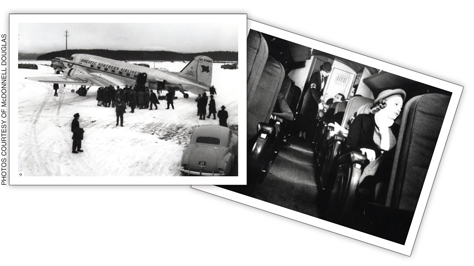
The DC-3: A bizav icon turns 75
No airplane has done more to mold business aviation history than the Douglas DC-3, which turns 75 on December 17.
During the 1950s, DC-3s ushered in the modern corporate aviation era. Visit any corporate flight department that has been around since then and odds are you'll spot a framed photo of its old DC-3. The model continued to ferry executives well into the 1980s, their roomy cabins compensating for a poky 140-nautical-mile-per-hour cruise speed.
The DC-3 evolved into an icon of popular culture. In 1952, the Detroit Pistons acquired one, becoming the first NBA team to have its own airplane. The model starred in numerous Hollywood epics. Radio impresario Arthur Godfrey regularly flew his own DC-3 from his Virginia farm to New York. It was the inspiration for Ernest Gann's bestselling 1961 novel, Fate is the Hunter. Ricky Nelson, the 1960s teen music idol, died when his 1944 DC-3 caught fire and crashed on New Year's Eve in 1985.
The model remains in the headlines. When an earthquake devastated Haiti last January, Missionary Flight International delivered one of the first emergency medical teams to Port-au-Prince in its DC-3. Three months later, when the Deepwater Horizon exploded in the Gulf of Mexico, DC-3s arrived to spray oil dispersants.
The model owes its longevity to its simple design, robust construction and flight characteristics. The airplane can carry 7,500 pounds of cargo and is famous for its ability to operate out of rough, short landing strips. However, it has its idiosyncrasies. Just about everything leaks-including the cockpit windows. The controls can be quirky. The radial piston engines belch smoke, soot and oil and are prone to failure.

Douglas Aircraft and its licensees built more than 16,000 DC-3s. The model transformed its manufacturer from a one-man operation in 1921 to the nation's fourth-largest company by 1944. By 1940, DC-3s represented 87 percent of all commercial aircraft in the U.S. They made the nation's airline and air freight businesses viable, expedited troop and supply transport in World War II and broke the back of the Soviets' 1948 Berlin blockade. A DC-3 was the first airplane to land at the South Pole.
Today, the U.S. Forest Service uses the model to deliver smoke jumpers to wild fires. DC-3s based at Long Beach provide a commercial link to Catalina Island. Canada's Buffalo Airways uses DC-3s to resupply diamond mines. They facilitate humanitarian relief in Africa; anti-terrorism support in Afghanistan; environmental research in Antarctica; military missions in El Salvador, Guatemala, Mali and Mauritania; geophysical surveys in South Africa; and cloud seeding in Thailand.
Over the years, companies have developed modernization programs for the DC-3, which all involve replacing the temperamental twin R-1830 engines with reliable, modern turboprops, and renaming the airplane. But to me, it's still a DC-3. A model of one sits on my desk. It reminds me of how far we have come-and why.-Mark Huber
During the 1950s, DC-3s ushered in the modern corporate aviation era. Visit any corporate flight department that has been around since then and odds are you'll spot a framed photo of its old DC-3. The model continued to ferry executives well into the 1980s, their roomy cabins compensating for a poky 140-nautical-mile-per-hour cruise speed.
The DC-3 evolved into an icon of popular culture. In 1952, the Detroit Pistons acquired one, becoming the first NBA team to have its own airplane. The model starred in numerous Hollywood epics. Radio impresario Arthur Godfrey regularly flew his own DC-3 from his Virginia farm to New York. It was the inspiration for Ernest Gann's bestselling 1961 novel, Fate is the Hunter. Ricky Nelson, the 1960s teen music idol, died when his 1944 DC-3 caught fire and crashed on New Year's Eve in 1985.
The model remains in the headlines. When an earthquake devastated Haiti last January, Missionary Flight International delivered one of the first emergency medical teams to Port-au-Prince in its DC-3. Three months later, when the Deepwater Horizon exploded in the Gulf of Mexico, DC-3s arrived to spray oil dispersants.
The model owes its longevity to its simple design, robust construction and flight characteristics. The airplane can carry 7,500 pounds of cargo and is famous for its ability to operate out of rough, short landing strips. However, it has its idiosyncrasies. Just about everything leaks-including the cockpit windows. The controls can be quirky. The radial piston engines belch smoke, soot and oil and are prone to failure.

Douglas Aircraft and its licensees built more than 16,000 DC-3s. The model transformed its manufacturer from a one-man operation in 1921 to the nation's fourth-largest company by 1944. By 1940, DC-3s represented 87 percent of all commercial aircraft in the U.S. They made the nation's airline and air freight businesses viable, expedited troop and supply transport in World War II and broke the back of the Soviets' 1948 Berlin blockade. A DC-3 was the first airplane to land at the South Pole.
Today, the U.S. Forest Service uses the model to deliver smoke jumpers to wild fires. DC-3s based at Long Beach provide a commercial link to Catalina Island. Canada's Buffalo Airways uses DC-3s to resupply diamond mines. They facilitate humanitarian relief in Africa; anti-terrorism support in Afghanistan; environmental research in Antarctica; military missions in El Salvador, Guatemala, Mali and Mauritania; geophysical surveys in South Africa; and cloud seeding in Thailand.
Over the years, companies have developed modernization programs for the DC-3, which all involve replacing the temperamental twin R-1830 engines with reliable, modern turboprops, and renaming the airplane. But to me, it's still a DC-3. A model of one sits on my desk. It reminds me of how far we have come-and why.-Mark Huber
